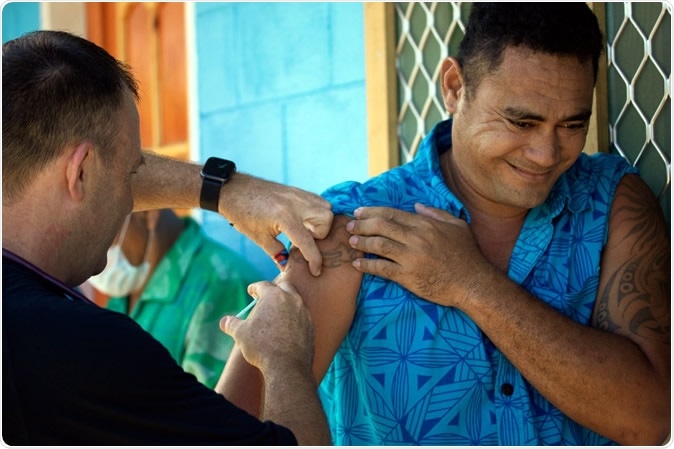Measles, a viral infection that is highly contagious is making a comeback over the past few years in several developed as well as developing nations. This is mainly due to the decline in vaccination rates that protect the community and the unimmunized.
This decline has been attributed to anti-vaccination campaigns that have raged over the internet and scared away many parents from vaccinating their children. Experts say that the years and efforts spent on eradicating this disease with the help of vaccination could be undone by the anti-vaccination stances taken up by populations.
Immunizations against the infection has saved 23 million lives between 2000 and 2018 says the World Health Organization (WHO). There have been outbreaks reported from Democratic Republic of Congo (DRC), Samoa and Ukraine says the WHO. One of the major causes behind these outbreaks is the failure to vaccinate the children adequately. There have been around 10 million cases of measles and 140,000 deaths due to the disease across the globe in 2018 says the WHO. The numbers have crossed thrice these numbers from the last reports analyzed in November 2019 says the health organization. 2019 remains a year with most number of cases of measles since 2006.
The WHO warns that at least 95 percent of the population of a country should be vaccinated against measles. This would provide herd immunity or protect the unimmunized 5 percent of the population. This 5 percent of the population includes babies below 6 months, elderly and those with suppressed immunity who cannot be vaccinated. The WHO reports that across the world only around 85 percent of the population has received the first dose and around 70 percent has received the second dose of the vaccine. These numbers have not changed much over the past decade says the WHO report. In 2018, the WHO along with Measles & Rubella Initiative and GAVI, geared up to vaccinate 346 million children across 37 nations through mass vaccination campaigns.
Measles is associated with several life threatening complications that is capable of killing those affected. The WHO has also undertaken efforts to detect and treat health complications such as pneumonia and respiratory infections and widen the coverage of vaccination.
The WHO website reports that in the DRC, one of the world’s most severe outbreak of measles is presently on. The nation’s all 26 provinces are affected and there have been 250,000 cases of measles and over 5,000 deaths in DRC in 2019 till date. There are many children who have not been vaccinated and many of them are also malnourished. Combining these two can lead to an increased risk to contracting measles and also developing complications associated with it.

Image Credit: WHO/John Kisimir
At present a five day mass vaccination campaign is being planned by the Ministry of Health with WHO and GAVI (a vaccine alliance) in the North Kivu where nearly 2.2 million children would be vaccinated against measles. Dr Deo Nshimirimana, WHO acting Representative in the DRC said in a statement, “In the context of North Kivu, where the population is highly mobile, it is imperative that we reach out to travellers and ensure that their children are also covered. Every child should receive his or her vaccine so that they are well protected and can grow up healthy.” After this another phase of mass vaccination would be started and this is slated to cover 18.9 million children across the country says the WHO.
Dr Matshidiso Moeti, WHO Regional Director for Africa said in a statement, “While the Ebola outbreak in the DRC has won the world’s attention and progress is being made in saving lives, we must not forget the other urgent health needs the country faces. This new vaccination campaign aims to protect children in North Kivu, as well as other parts of the country from a disease that is easily preventable with a vaccine.”
The Pacific island of Samoa is another nation hit with the measles outbreaks with more than 4,200 cases and over 60 deaths. A vaccination drive aimed at covering 76 percent of the infants and children aged between 6 months to 4 years. Soon the country aims to cover 95 percent of the population under the vaccination drive. This drive is being aided by the WHO, Australia, New Zealand, UNICEF and others. Dr Rasul Baghirov, WHO Representative in Samoa, said in a statement, “Samoa’s health services are working stoically, day and night, to get life-saving vaccinations who need them and to give crucial treatment for those critically infected. We’re helping to detect, map and stop measles’ spread, and have deployed our technical specialists in epidemiology, cluster coordination, infectious diseases, vaccination and risk communications to assist.”

Image Credit: WHO/Rose Anysley
Another nation under the microscope for measles vaccine drives is Ukraine. The WHO states that in 2016 only one in three Ukrainian children received their second dose of measles. There have been problems of vaccine supplies over the last few years says the WHO. At present the vaccine drives have successfully covered over 90 percent of the Ukranian parents and motivated them to vaccinate their children. Jarno Habicht, WHO Representative in Ukraine said in a statement, “One of the biggest challenges we have is to sustain the momentum and commitment we’ve seen in the last few years.” “We need to push harder to hit that 95% needed in every community - every year - to prevent future outbreaks… It’s also crucial to cover those that missed vaccination before, and to push forward progress on routine immunization programmes so we don’t see another spike in cases in the coming years,” said Habicht.